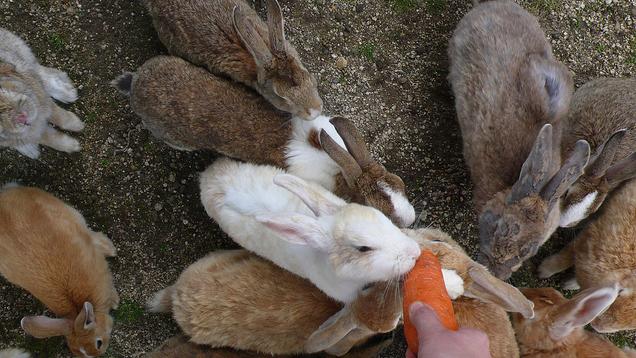Cuddly Rabbit Island in Japan has something of a sinister past
Bunnies are the main population on Okunojima in Japan.
Looking for a honeymoon spot? Why not consider the tiny island of Okunojima?
It's already popular with Japanese tourists — though you might better understand why if you knew its other name.
Ellis Krauss directs the University of California exchange program in Japan and he takes his students to visit this pretty little island better known as Rabbit Island or Bunny Island. It's also referred to as Ōkunoshima.
"It's absolutely beautiful," Krauss said. "You can't avoid the bunnies, they're everywhere."
And he means everywhere. Hundreds of them live on the island, which is less than half a square mile in area. But the island, part of a national park, is also hopping with tourists. There's a golf course, playgrounds, tennis courts, hiking trails and even a honeymoon hotel. Which is strange, says Krauss, because this warm and fuzzy Island actually has a pretty chilling past.
"This would be a little like creating a honeymoon hotel in Los Alamos, or where the atom bomb was invented," Krauss said.
For nearly 20 years, from 1929 until the end of World War II, Bunny Island was the center of chemical weapons research and production in Japan.
"It was a super secret island during the war. Trains had to lower their shades so that passengers couldn't see the island during the war," Krauss said. "Everyone who worked on the island was sworn to secrecy."
More than 6000 tons of poison gas was produced on the island. And the test subjects for the chemicals, according to Krauss, were the bunnies, though the bunnies currently living on the island aren't descendents of the bunnies tested, says Krauss. The original bunnies were euthanized in 1945 when the Americans occupied Japan and took over Okunojima island. No one knows exactly where the current population came from, though rumors include a pair of British tourists and a group of schoolchildren all leaving a small number of bunnies on the island — who then did what bunnies do.
Roughly half of the weapons manufactured on the island were shipped to China and used in Japan's invasion of China in 1937, Krauss says.
"I believe about 80,000 Chinese were killed by these weapons," Krauss said. "And in the little museum on the island, there are actually pictures of Japanese soldiers with gas masks in China using the chemical weapons."
The other half of the chemical weapons stockpile, the portion kept in Japan, was dumped into the ocean by occupying American forces. Gas that went unused in China was buried on the Chinese/Russian border.
Today as you hike around the tiny island, it's hard not to bump into remnants of its past: a dilapidated lab building, crumbling bunkers used to store weapons. And then, of course, there are the hordes upon hordes of bunnies, which from the endless online videos of tourists feeding them, look unnaturally large and aggressive.
One final note on Bunny Island. It's located just an hour and a half from another horrific World War II landmark, Hiroshima.
"The existence of this island with it's past so close to Hiroshima really represents the two sides of the Pacific war," argues Krauss. It shows "what we did to the Japanese in Hiroshima, and it shows the type of militaristic behavior that Japan did during and before the war, represented by Bunny Island," where the Japanese produced chemical weapons that were used on other people.
We want to hear your feedback so we can keep improving our website, theworld.org. Please fill out this quick survey and let us know your thoughts (your answers will be anonymous). Thanks for your time!
